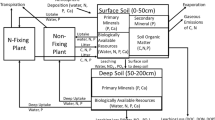Abstract
In extreme deserts with precipitation of less than 10–20 mm/yr, biocoenoses occur which are void of producers but show ecosystem functions such as food chains and energy flow. Since they are fed by the importation of allochthonous organic material the term ‘allochthonous ecosystems’ is proposed to designate these systems. The application of this term to other incomplete ecosystems without producers is discussed.
Similar content being viewed by others
References
Alaily, F., Bornkamm, R., Kehl, H. and Renger, M. 1987. Evaluation of land in SW-Egypt. Berliner Geowiss. Abh. 75(1): 517–544.
Bornkamm, R. 1987. Growth of accidental vegetation on desert soils in SW Egypt. Catena 14: 267–274.
Bornkamm, R., Lee, J.A. and Seaward, M.R.D. (eds.) 1982. Urban ecology. Blackwell, Oxford, London, Edinburgh, Boston, Melbourne.
Jalas, J. 1955. Hemerobe and hemerochore Pflanzenarten. Acta Soc. Pro Fauna et Flora Fenn. 72: 1–15.
Kassas, M. 1952. Habitat and plant communities in the Egyptian desert I. Introduction J. Ecol. 40: 342–351.
Kühnelt, W. 1965. Nahrungsbeziehungen innerhalb der Tierwelt der Namibwüste (Südwestafrika). Sitzungsber. Österr. Ak. Wiss. (Wien) Abt. I 174: 185–190.
Kühnelt, W. 1976. Beiträge zur Kenntnis der Nahrungsketten in der Namibwüste (Südwestafrika). Verhandl. Ges. f. Ökol. Wien 1957 (The Hague): 197–210.
Maarel, E. van der 1975. Man-made ecosystems in environmental management and planning. In Unifying Concepts in Ecology. pp. 263–274. Edited by W.H. Dobben and R.H. Lowe-McConnell. Dr W. Junk Publishers, The Hague.
Naumann, E. 1932. Grundzüge der regionalen Limnologie. Die Binnengewässer, Bd. II. Schweizerbart (Stuttgart).
Odum, E.P. 1959. Fundamentals of ecology. 2nd ed. Saunders, Philadelphia and London.
Odum, E.P. 1971. Fundamentals of ecology. 3rd ed. Saunders, Philadelphia and London.
Stahr, K., Bornkamm, R., Gauer, J. and Kehl, H. 1985. Veränderung von Böden und Vegetation am Übergang von Halbwüste zur Vollwüste zwischen Mittelmeer und Qattara Depression in Ägypten. Geoökodynamik (Bensheim) 6: 99–120.
Sukopp, H. 1969. Der Einfluβ des Menschen auf die Vegetation. Vegetatio 17: 360–371.
Tansley, A.G. 1935. The use and abuse of vegetational concepts and terms. Ecology 16: 284–307.
Thienemann, A. 1955. Die Binnengewässer in Natur und Kultur. Springer (Berlin-Göttingen-Heidelberg).
Walter, H. 1973. Die Vegetation der Erde in ökophysiologischer Betrachtung. Band I. VEB G. Fischer, Jena.
Walter, H. 1985. The Namib Desert. In Hot Deserts and Arid Shrublands. Ecosystems of the World 12A. pp. 245–282. Edited by M. Evenari, I. Noy-Meir and D.W. Goodall. Elsevier (New York-Tokyo).
Author information
Authors and Affiliations
Rights and permissions
About this article
Cite this article
Bornkamm, R. Allochthonous ecosystems. Landscape Ecol 1, 119–122 (1987). https://doi.org/10.1007/BF00156233
Issue Date:
DOI: https://doi.org/10.1007/BF00156233




